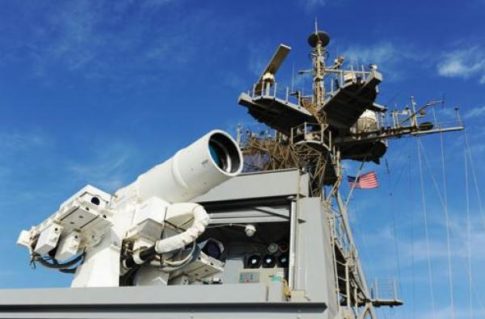– US Navy To Begin Testing Powerful 150-Kilowatt Laser Weapon System:
It’s always good advice to be preparing for the future, especially in the case of the United States military as the US continuously provokes other nations.
As Popular Science reported back in 2014, the US Navy had developed a 30-kilowatt laser and mounted it on the USS Ponce, which was stationed in the Persian Gulf at the time. The laser was part of the US Navy’s new Laser Weapon System (LaWS) program, and with a videogame-like controller it had been successfully tested.
In this video, the laser will engage and destroy multiple targets including a drone in mid-air.
* * *
“Laser weapons are powerful, affordable and will play a vital role in the future of naval combat operations. We ran this particular weapon, a prototype, through some extremely tough paces, and it locked on and destroyed the targets we designated with near-instantaneous lethality.” Rear Adm. Matthew L. Klunder said at the time.
A press release went on to say that that not only is the laser lethal, it’s relatively cheap to use as well: “At less than a dollar per shot, there’s no question about the value LaWS provides. With affordability a serious concern for our defense budgets, this will more effectively manage resources to ensure our Sailors and Marines are never in a fair fight.”
After watching the video, one would assume that a 30-kilowatt laser would suffice, however that isn’t the case. As PopSci reports, the Navy is going to go bigger, much bigger.The US Navy will now be performing tests of a 150-kilowatt laser, in an effort to upgrade capability and eventually to become part of every service platform.
National Defense Magazine has more on the high powered laser:
The U.S. Navy, which has already developed a 30-kilowatt laser that has been used operationally, will soon test a new directed energy weapon that is five times more powerful, said the vice chief of naval operations July 23.
The Office of Naval Research “will perform a shipboard test of a 150-killowatt laser weapon system in the near future,” said Adm. Bill Moran during a speech at Booz Allen Hamilton’s Directed Energy Summit, which was held in Washington, D.C.
The Navy’s 30-kilowatt laser weapon is currently onboard the USS Ponce. The system, which has been used operationally in the Persian Gulf, offers military leaders precision accuracy at a low cost, Moran said.
The laser weapon system, or LaWs, “has an extremely low-cost per engagement ratio,” he said. “We’re spending pennies on the dollars … every time we use that capability.”
While the U.S. military is developing laser weapons that can be installed on platforms across the Army, Air Force, Navy and Marine Corps, military leaders must be cognizant that potential adversaries are as well, Moran said.
“These technologies are being developed and fielded by a growing number of countries all around the world, it’s not just us,” he said. “If we don’t get ahead of that capability by our adversaries, we’re going to find ourselves in a very difficult position in the future.”
As the Navy considers its future fleet design, laser weapons must be a part of the equation, Moran said.
“If we have to continue to rely on projectiles, propellant-driven projectiles, we will run out of our ability to defend ourselves over time,” he said. “This capability in directed energy is incredibly important.”
* * *
So the future of warfare has now arrived, and it looks like it will be US high powered lasers vs Russian hypersonic glide vehicles at some point in the future. And by some point in the future we mean sooner rather than later if the global economy continues to melt down, because as every knows, after the central bank money printing game is up, the next play in the elitist playbook is war.
* * *
PayPal: Donate in USD
PayPal: Donate in EUR
PayPal: Donate in GBP
